
Related
Guests
- Ollie Vargasjournalist with Kawsachun News.
- Eduardo González CuevaPeruvian sociologist and human rights expert.
Links
We go to Peru for an update after Peruvian authorities declared an overnight curfew in parts of southern Peru as mass protests continue following the ouster and arrest of leftist former President Pedro Castillo. At least 17 people were killed Monday after security forces opened fire at anti-government protesters in the city of Juliaca, and over 40 people have been killed across Peru over the last month, with human rights groups accusing the authorities of using indiscriminate force against protesters. The country’s crisis started in early December when then-President Castillo attempted to dissolve Congress and rule by decree, resulting in his arrest and replacement by his vice president. We are joined from Desaguadero, Peru, near the Bolivian border, by Ollie Vargas, a journalist with Kawsachun News, who says protesters are demanding new elections, the resignation of Castillo’s successor Dina Boluarte and the formation of a constituent assembly to draft a new constitution. A major contributor to the current crisis is “the extreme weakness of the political system in Peru” in which many politicians lack any real connection to their constituents, adds Peruvian sociologist Eduardo González Cueva.
Transcript
AMY GOODMAN: Peruvian authorities have declared an overnight curfew in parts of southern Peru as mass protests continue following the ouster and jailing of leftist President Pedro Castillo. At least 17 people were killed Monday after Peruvian security forces opened fire at anti-government protesters in the city of Juliaca. At least two teenagers were among the dead. Three days of mourning are being held in the region. Some 40 people have died nationwide since mass protests erupted in Peru last month. Protesters are calling for Castillo to be released from prison and for his successor, Dina Boluarte, to resign as president.
JULIA ESPINOZA: [translated] We are demanding our rights. That rotten coup Congress let them get away with the genocidal Dina Boluarte. They do not represent us. They kill our brothers and sisters.
AMY GOODMAN: Protesters have set up massive roadblocks in southern Peru, calling for the resignation of the interim president, who had been vice president, Dina Boluarte. This is a protester speaking near the Peruvian-Bolivian border.
ANTONIO CHOQUE: [translated] Right-wingers have ousted the government of our president, Pedro Castillo. The Peruvian Congress ousted him. The Peruvian people don’t support Congress. We don’t support newly appointed President Dina Boluarte, and we want her immediate resignation, the closure of Congress and a new constitution.
AMY GOODMAN: On Tuesday, Peru’s Prime Minister Alberto Otárola defended the use of force against protesters, accusing them of trying to take over an airport in Juliaca. Otárola also announced a curfew in the southern Puno region.
PRIME MINISTER ALBERTO OTÁROLA: [translated] Compulsory social immobilization in Puno for three days, from 8 p.m. to 4 a.m., to safeguard the life, integrity and freedom of all the citizens of Puno.
AMY GOODMAN: Peru has been in a state of crisis since December 7th, when the right-wing Peruvian Congress voted to remove President Castillo after he moved to temporarily dissolve the Peruvian Congress ahead of an impeachment vote. Castillo is a left-leaning former teacher and union leader from rural Peru who was president for less than a year and a half before his ouster. In 2021, he defeated Keiko Fujimori, the daughter of Peru’s former dictator Alberto Fujimori. Protesters accuse the Peruvian Congress of unfairly targeting Castillo ever since he defeated Fujimori.
There are two guests with us right now. Eduardo González Cueva is a Peruvian sociologist and human rights expert, joining us from here in New York City. And in Peru, we’re joined by the Bolivian-based journalist Ollie Vargas. He’s a co-founder of Kawsachun News. He’s joining us from Desaguadero, Peru, near the Bolivian border.
We welcome you both back to Democracy Now! Ollie Vargas, let’s begin with you. Can you tell us what’s happening there right now? And give us the broader context of why this is all taking place.
OLLIE VARGAS: Thank you, Amy.
And, yeah, I’m here in Desaguadero, Peru, which is in the Puno region in southern Peru, very close to the Bolivian border. And, well, I arrived here yesterday, and my intention was to go to Juliaca, where the massacre took place on Monday. However, that is pretty much impossible because there are so many roadblocks, essentially barricades, erected by protesters all along all of the roads in this region. It is not possible to really move about at all in any way. And, yeah, at every point, there is huge numbers of protesters who have erected barricades, whether through metal sheets, sort of giant rocks, and have essentially paralyzed the southern part of the country. There’s also similar barricades erected in some Amazonian cities, like Pucallpa and Ucayali, and also near the coast, for example, Ica.
And, yeah, the sense I got from speaking to people yesterday is that people are getting ready for the long haul. People are ready to take part in what is a general strike in these areas for the long haul. I don’t know how much you can see behind me, but there is actually — everything is boarded up. Nothing is open. Everyone is taking part in this general strike.
And the demands of people are the resignation of the president, the immediate elections — because the regime had said that they want to have elections in 2024. They’ve said, no, they have to be now. People want a constituent assembly to draw up a new constitution. And these demands are essentially completely unacceptable to the government. And these demands are, essentially, completely unacceptable to the government.
And the government, I think, have backed themselves into a corner, especially with the massacre we saw on Monday, but also the deaths before that. There’s a total of 46 deaths since the government took power. They’ve only been in power about 40 days. So, the level of human rights abuses they’ve committed means that they cannot necessarily, you know, have a negotiated way out of power, because they will face prosecution, they will face possible jail time. And so, really, their only options would be to either — if they were to resign, to leave the country or to — I think, which is more likely, to dig their heels in and increase the repression.
And in this southern region, they imposed a curfew last night. That wasn’t observed here in Desaguadero. There’s actually really no state presence at the moment. Government workers have been withdrawn from these regions by the central state, so there’s actually no way of enforcing that. There’s no police at all. They have withdrawn from these areas, as well. So, it’s an incredibly tense situation, and protesters give no sign of backing down from their demands, which are essentially the fall of the government.
JUAN GONZÁLEZ: And, Ollie, I wanted to ask you if you could talk about what’s being portrayed as a divide between the countryside and the cities of Peru. To what degree are the protesters largely from the Indigenous populations of Peru? And how does race and how Castillo had been perceived previously by the elite in Peru involved in what’s happening here?
OLLIE VARGAS: Absolutely, that divide is — the political divide is also a class and racial divide at the moment. And all of the protests and the general strike is concentrated in southern Peru. And southern Peru is overwhelmingly Indigenous. This particular area here near the Bolivian border is predominantly Aymara. That’s people’s first language. But there’s also — the strike is very strong in places like Cusco, where people are predominantly Quechua Indigenous. And so, this is the epicenter of the movement, which is a predominantly Indigenous region.
And people don’t feel represented in any way whatsoever by the central state in Lima, and primarily because of the racism that comes out of the capital city. We’ve seen with this past few weeks with the protests, the government ministers and also the media based in the capital city have talked in an incredibly discriminatory way about people here, calling them the “Indians,” the “savages,” the “terrorists,” the “ignorants.” And there’s even some people — certainly not a majority, but some people even say that “We don’t feel very Peruvian, because we’re told constantly that we’re not equal citizens, that we’re not Peruvians like the people in the capital city. So, if we’re not recognized as Peruvians, why should we remain part of Peru?” And a lot of people don’t feel any identification or attachment with those in the capital city.
And, you know, just on an anecdotal level, I used to live in Lima a few years ago. And the way the people, a lot of people, especially middle-class people, in Lima would talk about Indigenous Andean Peruvians was in a way that didn’t recognize them as fellow citizens. They would talk about the “invaders” or the “immigrants,” talking about people — you know, calling people immigrants within their own country. So, this is the context, really, behind this.
And people here felt that Pedro Castillo was the first president, really, in Peruvian history that is like them, that represents them, that knows their issues and their struggles. And they didn’t even let him finish one term. Within a year and a half, he was ousted by the Congress, in which the majority are right-wing parties, a majority of people are not reflective of the country, are not Indigenous, as well as the police and the military. I think those three institutions really were who ousted Pedro Castillo.
And now there’s a new government in power that no one voted for. And people feel, “Well, what was the point of us having a say, if that say is not being respected by the people in Lima, if the government is just decided by people by backroom deals in the capital city? So, there’s a huge amount of resentment about that, about the racial discrimination that comes from the capital city.
AMY GOODMAN: Let’s turn to hear from some of the protesters who were injured Monday when the Peruvian security forces opened fire on the anti-government protesters in the city of Juliaca, killing at least 17 people.
INJURED PROTESTER: [translated] I was holding my camera when a police officer asked me to kneel while pointing a gun at me. Then I heard a shot, and I felt my foot blocked. Then I felt a cramp. I took four steps, and I fell on the ground because I couldn’t walk.
UNIDENTIFIED: [translated] He was walking around because his friend lives nearby. They went for a walk. And as far as we know, a bullet hit him.
JOURNALIST: [translated] Where did it hit?
UNIDENTIFIED: [translated] In the abdomen. All the intestines are injured.
JUAN GONZÁLEZ: Eduardo González Cueva, a Peruvian sociologist and human rights expert, I’d like to bring you into the conversation. Could you talk about your perspective of what’s going on here, and also talk about the reality that the current interim president, Dina Boluarte, was an ally of Pedro Castillo before he was ousted from office?
EDUARDO GONZÁLEZ CUEVA: Juan, thank you for having me and for your question.
The first thing that we need to understand is that the political system in Peru is extremely fragile. The political parties simply have very little representation, and they are mostly electoral vehicles for quite opportunist actors. The formula that led Castillo to government at the beginning didn’t even appear in the polls, and it catapulted to the top because of the image of Castillo. Boluarte was a person that nobody really knew. She was just in the presidential formula decided by the party bosses. And so, to say that Boluarte was an ally meant simply that she was in the formula, but there was no connection between the, let’s say, some kind of party discipline or party identity. Castillo himself was invited by the party boss to be the candidate, in the initial calculation that with his image they would get a few parliamentarians.
So, that is the context, the extreme weakness of the political system in Peru, the fact that this political system really does not represent the electors at all, and therefore that we are reduced to a very degraded form of representation. This is symbolic representation, whether the person who is in power feels like me, rather than a representation of interests, a representation in the political arena. So, this is the source of the problem.
AMY GOODMAN: On Monday, Peru’s prime minister announced Dina Boluarte’s government had banned former Bolivian President Evo Morales from entering Peruvian territory. This is what he said.
PRIME MINISTER ALBERTO OTÁROLA: [translated] The superintendency has decided to ban former Bolivian President Evo Morales from entering the country, and that of various of his Bolivian supporters, for directly violating this law, Article 48, which establishes that those people who threaten or disrupt internal order do not enter Peru. … We are closely watching not only the attitude of Mr. Morales, but also of those who work with him in southern Peru, who, as all of you have been able to see in the last few months or days, have been very active in fueling the crisis.
AMY GOODMAN: So, that’s Peru’s current prime minister. Ollie Vargas, you’re right there on the border between Peru and Bolivia. Can you talk about the significance not only of banning Evo Morales, but what this means for what’s happening in Bolivia, as well, and for all of Latin America? And where is Castillo right now? He’s jailed where? Near you?
OLLIE VARGAS: Yeah, well, Pedro Castillo is in police custody in Lima, in the capital city. He’s being held there without charge. He was given 18 months of preventive detention.
But, yeah, in terms of Evo Morales, I mean, this is really about the government looking for a scapegoat and looking for a way to explain away social protest. I think it’s something that a lot of governments around the world will do in the face of, you know, a population that is on the streets, saying, “Oh, this is foreign actors. There’s some secretive puppet master pulling the strings. This isn’t genuine social protest.” And so, they’ve chosen Evo Morales.
And the reason they’ve chosen Evo Morales is because in southern Peru there is a great deal of admiration for him. And, I mean, just yesterday, I was speaking to one of their protesters. He said, “We want a president like Evo Morales.” And the first reason he gave was actually around the nationalization of natural resources. He said, “In Peru, for a canister of natural gas,” which people use for cooking and heating their homes, etc., “we pay 10 times more than in Bolivia for the same thing. Why? Because in Bolivia, natural gas is nationalized, and the distribution is done by the state at fair prices, whereas in Peru, it’s all privatized. Foreign companies sell it back to the Peruvian people at sky-high inflated prices. And, you know, we look at what’s going on in Bolivia with great admiration.” And a lot of people in southern Peru, because we’re close to the border, you know, some people come to Bolivia for work, to sell goods, etc., at different markets. And so they can see the kind of economic growth that Bolivia has had during the period of Evo Morales, and now with President Luis Arce. And so, there is — yeah, there certainly is that level, that sort of image of Bolivia, and the Peruvian government is very aware of that, so they’re trying to use that to blame Evo Morales for social protest.
But people were actually very, very offended by that, because it means that they’re delegitimizing the reason that people are coming onto the streets. Of course, it has nothing to do with Evo Morales; this has to do with Peruvian domestic politics and the way that Peruvians are unhappy at the national government. And to say that they are being used by some behind-the-scenes puppet master is to say that they don’t have legitimate reasons to come out onto the streets. And so, that has actually angered people more. That has put the protesters even more entrenched in their positions, more determined to sort of stay in for the long haul. And so, I think while this discourse would play to the government’s middle-class supporters in the capital city and, you know, the ideas they have about Bolivian Indigenous people, in terms of actually resolving the situation, it’s actually made it a lot worse and made the situation a lot more tense.
JUAN GONZÁLEZ: Yeah, I’d like to ask Eduardo González Cueva — Peru — the modern history of Peru has been marked by profound class and racial struggles — of course, decades ago, the guerrilla war of the Sendero Luminoso and then the Fujimori dictatorship. Could you talk about the demands of the protesters now for a constituent assembly and new constitution? What is the problem with the existing Constitution in Peru?
EDUARDO GONZÁLEZ CUEVA: Well, we have a problem that is very similar to other countries that experienced a transition to democracy. Think of Chile. Chile and Peru, we’re very similar in the sense that when we both achieved a transition to democracy, we kept the constitution that had been written by the dictatorship. And that created, of course, a number of political imbalances that had to be corrected at some point.
In Chile, you saw how that ended. There was a demand for a constituent assembly. Regrettably, they were unable to pass a new constitution.
In Peru, when Fujimori escaped the country in the year 2000, there was a movement towards an integral transition. That is why we had a Truth and Reconciliation Commission, trials on human rights abuses, reparations to victims. But at the same time, the constitution of Fujimori was kept untouched. And not only that, in link with that constitution, the economic model that was installed by Fujimori, the neoliberal model, was untouched, which meant that, of course, Lima benefited from the resources that were extracted from the provinces. Lima benefited greatly because of the commodities boom that took place in the first two decades of this century, while the theory was that progress would trickle down to the provinces or to the middle and lower classes.
So, that is the original sin of Peruvian democracy, that there was a transition in 2000, 2001, towards the ideals of democracy after the personalistic rule of Fujimori, but we kept the rules of the game that were designed by Fujimori and for Fujimori.
JUAN GONZÁLEZ: And what do you see as a possible solution to the current crisis? Do you fear a direct — a return to dictatorship with the military backing that approach?
EDUARDO GONZÁLEZ CUEVA: Well, right now I am extremely pessimistic, and I don’t see many ways forward. I agree very much with what has been said in this program, that the willingness of the population that is protesting is to hold on for the long haul. They are prepared, I think, to demonstrate as much as they can. And, of course, the government is also pretty much in a trench and is demonstrating that it’s decided to exercise maximum force against the demonstrators.
So, basically, what we are going to see in the next few months, I believe, is a simmering crisis with these kinds of spasms of violence, depending on operations that the police launches against demonstrators. And we will have to see whether the protests actually move from the current area where they are, which is basically the south, the areas that voted for Castillo, the areas that have a high rural and Indigenous population, to Lima, to the capital.
I think that the government in Peru has this very cynical calculation that if the killings happen outside of Lima, if the killings happen in Indigenous areas, they are not going to worry Lima, and they are going to allow the government to function. That is, of course, not just profoundly immoral, it’s ahistoric, and it’s also economically suicidal, because Peru lives from mining, that happens to be located mostly in the southern territories.
So, that is what is going on. I think that we are going to see this simmering crisis, spasms of violence. And we will see whether the protests can actually have a foothold on Lima.
AMY GOODMAN: Well, Eduardo González Cueva, we want to thank you so much for being with us, Peruvian sociologist and human rights expert, and Ollie Vargas, reporter with Kawsachun News, joining us from the Bolivian-Peruvian border in southern Peru.
Next up, we speak to a striking nurse and a journalist who’s documented how hospital CEOs here in New York are boosting their own pay by millions while slashing charity care. And we’ll look at crypto bros wanting your 401(k), how regulators are being asked to allow crypto into the retirement market. Stay with us.

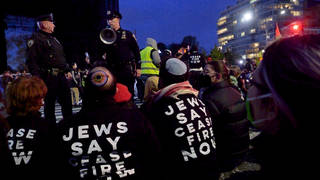
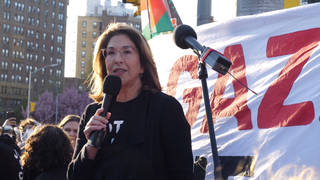
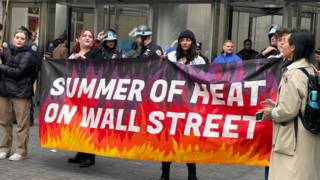
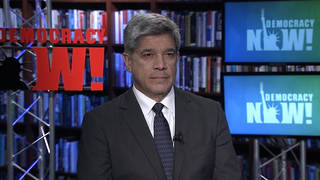





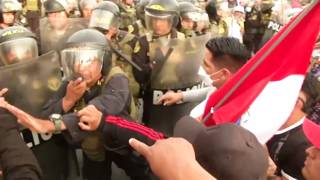
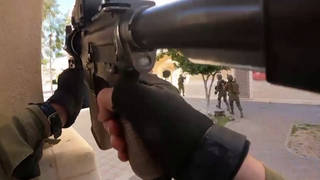
Media Options